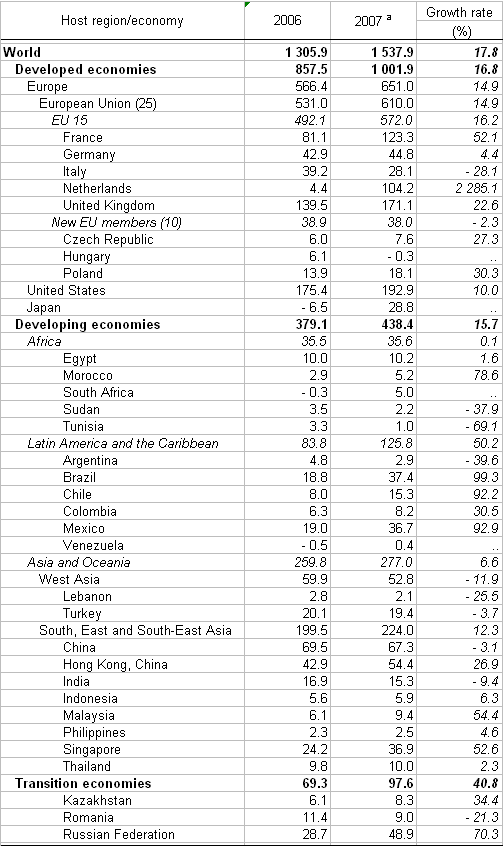Global foreign direct investment (FDI) inflows grew in 2007 to an estimated US$1.5 trillion, surpassing the previous record set in the year 2000, UNCTAD investment experts said today.
UNCTAD, reviewing year-end figures, said FDI continued to rise in all of three groups of economies -- in developed countries, developing economies and in South-East Europe and the Commonwealth of Independent States (CIS) -- largely reflecting the high-growth propensities of transnational corporations (TNCs) and strong economic performance in many parts of the world. Increased corporate profits and an abundance of cash boosted the value of the cross-border mergers and acquisitions (M&As) that constitute a large portion of FDI flows, although the value of M&As in the latter half of 2007 declined.
The financial and credit crisis that began in the latter half of 2007 has not affected the overall volume of FDI inflows, UNCTAD economists said. Even with a slowdown of the United States economy, the depreciation of the US dollar may have helped to maintain high levels of FDI flows into the country, in particular from countries with appreciating currencies, such as Europe and developing Asia. While sub-prime loan problems have impinged on the lending capabilities of banks, new capital injections from various funds, including sovereign wealth funds, have helped alleviate some of the problems.
FDI flows to developed countries in 2007 grew for the fourth consecutive year, reaching US$1 trillion. Flows were particularly buoyant in the United Kingdom, France, and the Netherlands. The United States maintained its position as the largest single FDI recipient. The European Union (EU) as a whole continued to be the largest host region, attracting almost 40% of total FDI inflows in 2007.
However, several risks to the world economy -- most of them not new -- may have implications for FDI flows to and from developed countries in 2008, UNCTAD said. High and volatile commodities prices may cause inflationary pressures, and a tightening of financial market conditions cannot be excluded. The increasing probability of a recession in the United States and uncertainties about global repercussions if it occurs may lead to a more cautious attitude by investors. These considerations underline the need for caution in assessing future FDI prospects for developed countries.
FDI inflows to developing countries and economies in transition (the latter comprising South-East Europe and CIS) rose by 16% and 41% (table), respectively, and reached new record levels, UNCTAD economists said.
In Africa, FDI inflows in 2007 remained relatively strong. The unprecedented level of inflows (US$36 billion) was supported by a continuing boom in global commodity markets. Cross-border M&As in the extraction and related service industries of Africa remained a significant source of FDI, but new inbound M&A deals also took place in the banking industry. Egypt, Morocco, and South Africa were the main beneficiaries of FDI inflows.
FDI inflows to Latin America and the Caribbean, meanwhile, rose by 50% to a record level of US$126 billion. Significant increases were recorded in the region´s major economies, especially Brazil, Chile and Mexico, where inflows doubled. This strong FDI growth was driven by greenfield investments (new investments and expansion) rather than cross-border M&As. This pattern was the result of strong regional economic growth and elevated corporate profits on the back of high commodity prices. Resource-based manufacturing explained a large part of incoming FDI to Brazil.
FDI inflows to South, East and South-East Asia, and Oceania maintained their upward trend in 2007, reaching a new high of US$224 billion, an increase of 12% over 2006. More than half of all FDI to developing countries went to these economies. At the subregional level, there was a further shift towards South and South-East Asia, although China and Hong Kong (China) remained the two largest recipients in the region.
In West Asia, overall FDI inflows declined by 12%. Turkey and oil-rich Gulf States continued to attract the most, but geopolitical uncertainty in parts of the region affected FDI overall.
FDI to South-East Europe and the CIS, or transition economies, expanded significantly, by 41%, to a new record of US$98 billion. This was the seventh year of uninterrupted growth of FDI in the region. Inflows almost doubled to the region´s largest recipient, the Russian Federation (table). While resource-rich countries (for example, Kazakhstan) received more than in 2006, it was the privatization of state-owned enterprises that drove FDI towards South-East Europe. FDI prospects for the Russian Federation, however, are affected by the impact of tightening Russian natural resource regulations and by disputes over environmental protection and extraction costs.
Despite some unfavourable economic projections for 2008 and potential tightening of rules for foreign investment in natural resources and related industries, high demand for natural resources around the world -- and, as a result, the opening up of new potentially profitable opportunities in the primary sector -- are likely to boost FDI in the extractive industries.
At the same time, continuing global external imbalances, sharp exchange-rate fluctuations, rising interest rates, and increasing inflationary pressures, as well as high and volatile commodity prices, pose risks that may have a chilling effect on global FDI flows, UNCTAD economists said.
ANNEX
Tables and figures
Table. FDI Inflows, by host region and major host economy, 2006-2007 (Billions of dollars)
Source: UNCTAD
Note: a - Preliminary estimates
World FDI inflows are projected on the basis of 105 economies for which date are available for part of 2007, as of 19 December 2007. Data are estimated by annualizing their available data, in most cases the first three quarters of 2007. The proportion of inflows to these economies in total inflows to their respective region or subregion in 2006 is used to extrapolate the 2007 data


